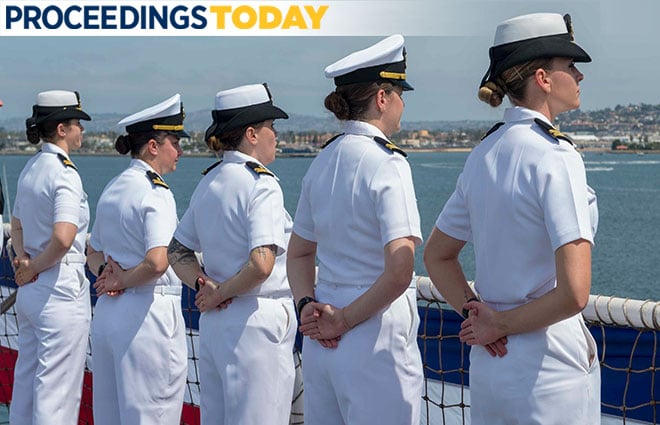
Recently, a male colleague asked me why female officers get so incensed over our uniforms, “Shouldn’t you be worrying about real issues?”
By dismissing the concerns of service members whose experience of putting on a uniform every day is different from his, he exemplified why it is such a hot-button issue. Ignoring female officers’ longtime, consistent concerns about uniforms says, “Your opinion about issues that concern you do not matter to leadership.”
I have written extensively about these uniform issues on the Task & Purpose blog in January 2017, June 2016, April 2016, and October 2015, examining how the push for gender neutral uniforms really is a ploy to force women to wear men’s uniforms—and then make them pay for them. Each article was widely read. Even CDR Salamander blogged about it. Military leadership, however, did not pay any attention.
Part of women’s frustration—and outrage—is that these changes were not requested. In 2013, the Office of Navy Uniform Matters conducted a Navy Women’s Uniform Survey, which found that 74 percent and 70 percent of female officers and chiefs, respectively, were satisfied with the professional appearance of the service dress white uniform with skirt. The items that registered the least satisfaction were the summer white and service khaki trousers, at 37 percent and 36 percent satisfaction, respectively. In response, the Navy chose to change the service dress whites and the combination cover—changes nobody wanted—and, for several more years, completely ignored the request to change the khaki and summer white trousers.
As a result, between now and 2020, female officers will have to spend nearly $400 on new uniform items they did not ask for, replacing the $400 of serviceable uniform items they already own. All of these new items also will require tailoring. Female officers will not be reimbursed. While some will shrug this off, saying “Officers make enough money to pay for it,” remember that this is an $800 tax that male officers are not required to pay—and their uniforms already are less expensive. This “tax” hits reservists particularly hard. When I was in graduate school, my drill pay was my sole source of income; many reservists drill for points and no pay, and even pay out of pocket to drill.
Despite more than four years of advocating on this topic, years of countless all-hands calls where women articulated their frustrations with and concerns about the very same issue to senior leaders, the changes still are being forced on us.
What is more confusing is that leadership has listened on a number of other issues—not only listening to women, but specifically addressing the long-ignored concerns of black women. For example, a recent, very welcome policy change allows women to wear their hair in braids, ponytails, and locks while in uniform. So, why is women’s self-advocacy dismissed in the case of uniform changes?
There are a number of issues related to female uniforms that have been ignored by multiple Secretaries of the Navy, Chiefs of Naval Operation, and Chiefs of Navy Personnel:
- Why do women’s uniforms cost more than men’s uniforms? If there is a different manufacturing cost, why isn’t this cost subsidized?
- Why are female officers forced to pay for new uniform items when data shows they did not want the changes?
- Why is there no transparency on the results of uniform wear test results that have taken place since 2013?
- Why does leadership not ask Congress to provide female officers a stipend if they are required to purchase items that male officers are not?
- Why are female officers not permitted to wear the bucket cover and old service dress white uniform until no longer serviceable?
- Why are female uniform items not stocked proportionally across the fleet? Ordering uniforms online is not an option because sizing varies widely and uniforms must be tried on first to ensure fit.
The following uniform changes have been asked for repeatedly by female officers, with no action by leadership:
- Permitting the wearing of “ballet-flat” style shoes in service and dress uniforms.
- Making the wearing of hose optional with uniform skirts.
- Retaining the use of the Navy work uniform (NWU) type III cover with rank insignia so service members do not have to stare at one another’s chests to discern rank.
Uniforms are how Navy officers present themselves to the world. Service and dress uniforms should give us the opportunity to confidently represent the U.S. Navy—not remind us that the Navy considers women to be odd bodies because our uniforms are ill-fitting and uncomfortable. The move toward unisex uniforms—which means putting women in men’s uniforms—only further implies that women’s presence should be muted and not celebrated as part of the strong plurality of our force. If the tables were turned, and unisex uniforms were designed to look more like women’s uniforms, men would revolt—as happened when the Marine Corps considered redesigning the male cover to resemble the female cover.
At a time when the Navy reports making strides to promote diversity and inclusion, the uniform changes that target only women have eroded the trust and faith of a generation of female Navy leaders. All women are asking for is transparency in the process, and to have their concerns heeded. It should not be so expensive to serve.
Lieutenant Goldstein served on active duty in the U.S. Navy from 2009 to 2016 as an intelligence officer and currently serves as a Navy reservist. She was a founding contributor to the veterans’ news and culture blog Task & Purpose and is a non-resident fellow at the Modern War Institute at West Point. She is a Pat Tillman Scholar and graduate of the Fletcher School of Law and Diplomacy at Tufts University.


